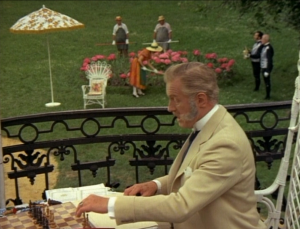Emmerich Kálmán is perhaps not the most well-known name in Western history, but in the small world of the operetta, it is often mentioned together with Johann Strauß jr., Franz Lehár, and Franz von Suppé in a list of the greats of the genre. Die Csárdásfürstin – Fürstin being German for princess and Csárdás being a traditional Hungarian folk dance that got popular in the ballrooms of Budapest and Vienna around 1900 – is probably his most well-known work. It is a story as old as time itself about a young nobleman being in love with an equally young maiden who sings and dances for her money in the Budapest Orpheum. Of course, things can never be straightforward in an operetta, so our noble protagonist is pressured in getting engaged to another woman. To announce their engagement, his parents organise a giant party. When the patriarch is organising this party, we are treated to the following scene:1
Gah! I had heard before of Hungarian nobility being fond of the most gruesome torture but I had no idea they also committed atrocities against Caïssa. This sort of thing does not belong on screen. And it definitely does not belong in an operetta! Operettas are supposed to be light-hearted! There is supposed to be dancing and merriment and ridiculously complicated plots that culminate in a big, happy ending!
Instead, we get a stuffy moustache pushing hapless pawns around, creating monstrosities man was never meant to see. As is usually the case with photographs of abominations, the resolution is not great and it is hard to say for sure that it’s not just a man in a suit. Identification is further hindered by the fact that the pieces used are not standard Stauntons. In fact, I went through dozens of piece designs from all over the world and didn’t find any reasonable match. Instead, we are confronted with weird, spindly pieces on far too wide a socle.
This makes it impossible to give a reconstruction – but do we really need one? Clearly, eight of the white pieces and the same number of black pieces are aligned on the fourth and fifth row respectively, meaning that the kings, wherever they are, are almost certainly in check.
Even if they weren’t, am I supposed to believe that some actual game led to a position where all the pieces were congregating in the middle, like some occult sect summoning demons from the Netherworld? Not! This will not stand! This behaviour must be punished immediately and severely! I must write a blogpost about it.
Realism: That which you call reality is not. It is but a mere shadow cast by the horrible intricacies of the net spun by the elder ones in a language incomprehensible to humans.
Probable winner: Gorefield,2 the devourer of lasagna and souls, who probably inspired this deviancy by means of the unearthly geometry that allows its forsaken adepts to travel through the astral planes at the cost of their sanity and their immortal soul.
1. [I should note that this is in the version directed by Miklós Szinetár with the Budapest Operetta Ballet; I don’t think the chessboard is integral to the operetta.] ↩
2. [Incidentally, this wiki gives Gorefield’s occupation as ‘Lovecraftian abomination’, which is also my dream job.] ↩
